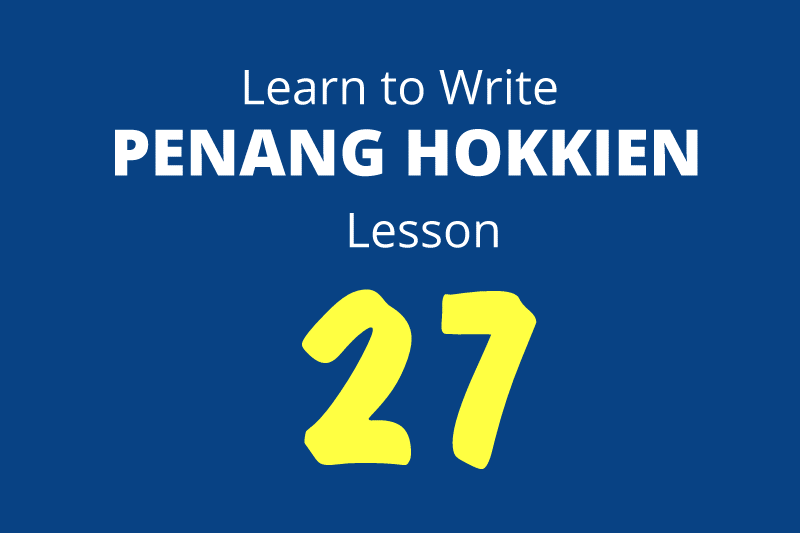
In this lesson we look at a group of words that contributes tremendously to bringing out the meaning of sentences in Penang Hokkien, but are often almost untranslatable in English. We have come across a few of them before, and indeed some of them have crept out of Hokkien to pepper the way we speak English locally.
I will not be going through every single particle in Penang Hokkien, but rather will be discussing their behaviour. To view a comprehensive list of particles, go to my chapter on Particles in Penang Hokkien.
I categorize particles into three main groups:
a) Emphatic Particles
b) Interrogative Particles
c) Time Particles
A) Emphatic Particles
Perhaps the most common contribution to local English is the particle "lah" which appears even in local English sentences. Yet it is just one of two different particles spelled "lah". The one we find in English is "lah4", which is used to stress or to persuade. It corresponds to our use of "do" in imperative sentences:
Lai2.

Come.
Lai2 lah4.

Do come.
Note that particles do not affect the tone of the word before it. In the above example, "lai2" is in the citation tone, and remains so with the inclusion of "lah4". The other "lah" particle in Penang Hokkien is lah3. This one does not appear in local English, and is used in Hokkien to express irritation or annoyance.
Lai2 lah3.

Come!
The particle "lah3" is employed to display some annoyance if an initial instruction is not followed through.
Lai4 and lah3 are just two of a whole group of particles which I collectively call as "emphatic particles". Their use is not to change the overall meaning of sentences, but rather to contribute emphasis.
We have met the particle "eh2" as a possessive particle (in wah1-eh2, ie1lang2-eh2, etc). We have also seen its use as a relative pronoun (Heh1-leh1 sau1 thor3kha1-eh3 lang2; the man who sweeps the floor). Eh2 resurfaces here as an emphatic particle at the end of sentences, to provide emphasis to an action. This particle also got adopted into local English, though translated as "one". Compare:
Ie1 phak3 wah4.

He beat me.
with
Ie1 phak3 wah4 eh2.

He beat me one.
As with the other particles, "eh2" carries with it some emotional properties, which is, to show a feeling of being disgruntled.
B) Interrogative Particles
These particles change declarative statements into questions. They include ah3
 , boay3
, boay3  , boh2
, boh2  , heo2
, heo2  , hna2
, hna2  , hna4
, hna4  , lai2
, lai2  , meh4
, meh4  , nee4
, nee4  , nia2
, nia2  , among those they can I recollect. But why so many particles for the purpose of asking questions? Because, in addition to asking, the particles inject some form of emotion to the question.
, among those they can I recollect. But why so many particles for the purpose of asking questions? Because, in addition to asking, the particles inject some form of emotion to the question.They may be used to seek clarity, to verify, to express incredulity, and so on. The same declarative statement can be turned into various questions by fitting a different interrogative particle at the end of it. They often carry shades of meaning that are very close to one another, so I would encourage you to use the language regularly to get used to their subtleties.
Ie1 gau2.

He's clever.
Ie1 gau2 boh2?

He's clever or not?
Ie1 gau2 nia2?

He's clever, isn't he?
Ie1 gau2 meh4?

Is he clever? (to express disbelief)
C) Time Particles
As there are no tenses in Penang Hokkien, we used time particles (which we can also call as adverbs) to show when an action is being carried out. They are the stand-ins for the Present Participles (which show actions on-going), and Past Participles (which show actions completed).
For on-going action, we add tiau2 and tuah3 to the sentence.
I eat bread.
Wah1 ciak3 lo3ti1.

I am eating bread. (I am in the midst of eating bread.)
Wah1 ciak3 tiau2 lo3ti1.

Wah1 ciak3 lo3ti1 tuah3.

For completed action, we add liau4 to the sentence.
I have eaten bread. (I have completed eating bread.)
Wah1 ciak3 lo3ti1 liau4.

I have finished eating the bread.
Wah1 ciak3 liau4 lo3ti1

Previous Lesson | Main Page | Next Lesson
Language Learning Tools
Use the following language learning tools to learn Penang Hokkien!Learn Penang Hokkien with uTalk
This app opens the door to over 150 languages.Return to Penang Hokkien Resources

Copyright © 2003-2025 Timothy Tye. All Rights Reserved.

 Go Back
Go Back
